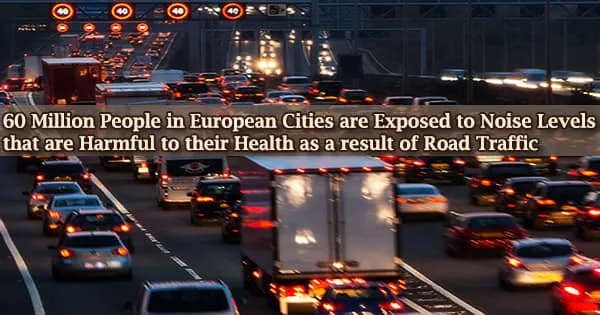The Barcelona Institute for Global Health (ISGlobal), a center financed by the “la Caixa” Foundation, conducted a study in 749 European towns to measure the levels of noise caused by vehicle traffic and its impact on health.
Nearly 60 million adults are exposed to dangerous levels of vehicle-generated noise, according to the findings, which were published in Environment International. Following the World Health Organization’s (WHO) noise-level limits could save 3,600 lives each year due to ischemic heart disease.
The biggest source of environmental noise is road traffic. Sleep disturbance, annoyance, cardiovascular and metabolic disease, bad birth outcomes, cognitive impairment, poor mental health and well-being, and early mortality have all been associated to environmental noise in previous studies.
Long-term exposure to road traffic noise can trigger a persistent stress response, resulting in the production of stress hormones as well as increased heart rate, blood pressure, and vasoconstriction, which can lead to chronic conditions like cardiovascular disease, depression, and anxiety disorders.
Data on European cities was obtained for this study from the Urban Audit 2018 dataset. Noise maps generated by countries and cities under the present European legal framework (Environmental Noise Directive) or available from local sources were used to estimate road traffic noise exposure (e.g. city governments and research institutions).
In the absence of city-level data, country-specific predictive models were built and used to assess exposure to road traffic noise. The Eurostat database was used to get data on various causes of death for the year 2015.
The findings revealed that more than 48 percent of the 123 million persons (aged 20 and up) in the research were exposed to noise levels that exceeded the WHO-recommended threshold.
The European directive on environmental noise made strategic noise mapping mandatory, but it did not set out a specific methodology or guidelines, so the results have been mixed. The EU member states have had a common methodology since January 2019, so we can expect to see much more comprehensive and accurate health impact assessments of traffic noise in the coming years.
Mark Nieuwenhuijsen
The average noise level recorded over a 24-hour period should not exceed 53 decibels (53 dB Lden), according to the WHO standard. In Europe’s main cities, the percentage of the population exposed to higher-than-recommended noise levels ranges from 29.8% in Berlin to 86.5 percent in Vienna, with 43.8 percent in Madrid and 60.5 percent in Rome.
Preventable Deaths and Annoyance
Based on earlier studies that found a link between noise and ischemic heart disease mortality, the researchers calculated that adhering to WHO guidelines would avoid more than 3,600 deaths from ischaemic heart disease alone each year.
The study also discovered that road traffic noise irritated over 11 million persons. Annoyance was defined as the disruption of daily tasks such as communicating, reading, working, and sleeping on a regular basis. In this sense, annoyance is more than just a nuisance; it can cause stress, which can lead to a variety of health concerns.
“Our results provide, for the first time, a comprehensive picture of European cities and a clearer understanding of why transport-generated noise is the second major environmental cause of adverse health outcomes in western Europe, after airborne particulate matter,” explained ISGlobal researcher Sasha Khomenko, lead author of the study.
“Even so, we are convinced that the true health impact of traffic noise is much greater, as the lack of city-level data limits the health effects we can assess, thus leading to an underestimation of the impact. Moreover, the available data have only allowed us to analyse the population exposed to more than 55 dB Lden, whereas the WHO-recommended threshold is 53 dB Lden, and we suspect that adverse effects could occur even with exposure to lower noise levels.”
Due to the variability and poor quality of the available data, the team ran into methodological issues. The quality of each noise map was evaluated, with the majority of the maps falling into the poor or moderate quality categories; only about 17% of the maps were deemed good quality.
“The European directive on environmental noise made strategic noise mapping mandatory, but it did not set out a specific methodology or guidelines, so the results have been mixed,” commented Mark Nieuwenhuijsen, head of the Air Pollution and Urban Environment programme at ISGlobal and senior author of the study.
“The EU member states have had a common methodology since January 2019, so we can expect to see much more comprehensive and accurate health impact assessments of traffic noise in the coming years.”
Consult Data for All 749 Cities
This research is part of the European Urban Burden of Disease Project, which has generated rankings of mortality linked to air pollution and green space in European cities thus far.
The results produced for the various cities studied are not deemed comparable due to variances in techniques and sources of traffic noise data. As a result, no road-noise rating was created, albeit all data was put on the project website, where all 749 cities’ values could be viewed.
















